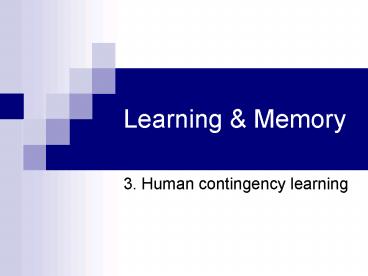Learning - PowerPoint PPT Presentation
1 / 22
Title: Learning
1
Learning Memory
- 3. Human contingency learning
2
Human contingency learning
- Goal Understanding human learning
- Key to understanding of the human mind
- Contingency learning is starting simple
- Commercial/social implications
- Traders predictions of stock market
- Stereotypical judgements about minorities
- The limits of evolutionary theory
3
Human contingency learning
Defining contingency
Accuracy of judgements
- Essential
- Wills, Ch. 2
- Shanks, Ch. 2
- Suppl
- Wills, Ch. 7
The effect of experience
Contingency chi-square 1117-5
Trial-order effects
Predictive redundancy
Rescorla-Wagner model
Before
After
During
4
Contingency chi-square
5
Contingency Thunder lightning
Outcome
Thunder
No thunder
6
1
Lightning
Cue
5
1
No lightning
6
Contingency Delta P
O
O
P(OC) 6 / (61) 0.86
C
C
P(OC) 1 / (51) 0.17
?P 0.86 0.17 0.69
?P P(OC) - P(OC)
7
Negative Delta P
- ?P P(OC) P(O-C) 0 1 -1
- ?P is maximally negative.
- Cue is a perfect predictor of the absence of the
outcome.
8
Zero Delta P
- ?P P(OC) P(O-C) 0.5 0.5 0
- ?P is zero.
- Cue and outcome are non-contingent.
- Common cues are not necessarily predictive cues.
9
Subjective contingency
- Subjective ratings and ?P
- ?P is an objective degree of relatedness (in
simple situations). - Significant evolutionary pressure for accurate
contingency estimation. - Subjective judgements should conform to ?P.
- Is this actually the case?
10
Accuracy of contingency judgements
11
Accuracy of contingency judgements
- Wasserman, Elek, Chatlosh Baker (93)
- One action - Telegraph key
- One outcome - Light flash
- Free operant procedure
- 4 minutes per condition
- 25 conditions
- P(OA) 0, 0.25, 0.5, 0.75, 1
- P(O-A) 0, 0.25, 0.5, 0.75, 1
- Judgement on scale of -100 to 100
12
Wasserman et al.
13
Lopez Shanks (Shanks 1995)
- Tanks colour-sensitive mines.
- One cue - Tank is coloured.
- One outcome - Tank explodes.
- 40 trials.
- Judgements (-100 to 100) every 5 trials.
- Four conditions
- 0.75/0.25, 0.25/0.75, 0.25/0.25, 0.75/0.75
14
Lopez Shanks
15
Why should experience matter?
?P P(OC) P(O-C) 0.5 0.5
0
?P P(OC) P(O-C) 0.5 0.5
0
- Perhaps theres more to contingency judgements
than delta P?
16
Trial order
- Chapman (1991)
- Simulated medical diagnosis
- Four cues - Symptoms A,B,C and D.
- One outcome - Disease.
- Three discrete stages of presentation
17
Trial order
- B rated as more negative than D.
18
Learning and surprise
- Baseline cues not associated with disease.
- A ? O Surprising - no disease expected
- AB ? no O Surprising - disease expected
- CD ?no O Unsurprising - no disease expected
- C ? O Surprising - no disease expected.
- Learning is driven by surprise.
- More is learned about B than about D.
- Hence, ratings are different.
19
Predictive redundancy
- Shanks (1991)
- Medical diagnosis 6 symptoms, 2 diseases
20
Predictive redundancy
- For any given outcome, we are more likely to
remember the most reliable predictors than the
least reliable. - Explained by the Rescorla-Wagner theory (see
lecture notes, readings, and next weeks
tutorial).
21
Summary
- Whilst ?P is an objective measure of contingency,
our judgements only correspond to it in simple
situations of which we have plenty of experience. - Where experience is slight, or heterogeneous over
time, or where an outcome has more than one
possible cause, ?P and our judgements differ. - The difference stems from the fact that
contingent relationships are learned
incrementally, whilst ?P is an after the event
reflection on the contents of a perfect memory.
22
What next?
Classical vs. FR 1121-2
- Essential
- Wills, Ch. 2
- Shanks, Ch. 2
- Suppl
- Wills, Ch. 7
Proto. theory evid. 1121-2
Instance theory evid. 1121-2
McC R 85 1121-2 (VRR)
Semantic Nets 1121-2 2021-7































